Abstract
1 Patients with poorly controlled epilepsy were cautiously transferred from multiple drug therapy to treatment with phenytoin sodium alone. One patient suffered more severe seizures and the initial treatment was restarted. The remainder showed no deterioration. 2 The daily dose of phenytoin was then increased by a small increment at intervals of 2 or more months. The serum phenytoin concentration (total and free) was measured regularly and response was assessed by records of seizure frequency and tests of speech, handwriting, short-term memory and coordination. 3 Patients (n = 11) with partial seizures showed no consistent improvement with increased phenytoin concentration within the range 15 mg/l (60 mumol/l) to the individual threshold for intoxication, greater than or equal to 35 mg/l (140 mumol/l). Patients (n = 4) with generalized seizures however were consistently improved at higher concentrations. 4 Tolerance to phenytoin varied, the threshold for symptomatic intoxication ranging from 35-60 mg/l (140-240 mumol/l) total and 2.7-5.2 mg/l (10.8-20.8 mumol/l) free. Ataxia was the commonest symptom and in some cases this was manifest by worsening of performance on the test of coordination (pursuit rotor). Even at lower phenytoin concentrations the patients performed less well on this test than control subjects. Other tests of performance showed no evidence of impairment at higher phenytoin concentrations. 5 The same daily dose of phenytoin tended to give higher serum drug concentrations after intoxication than before.
Full text
PDF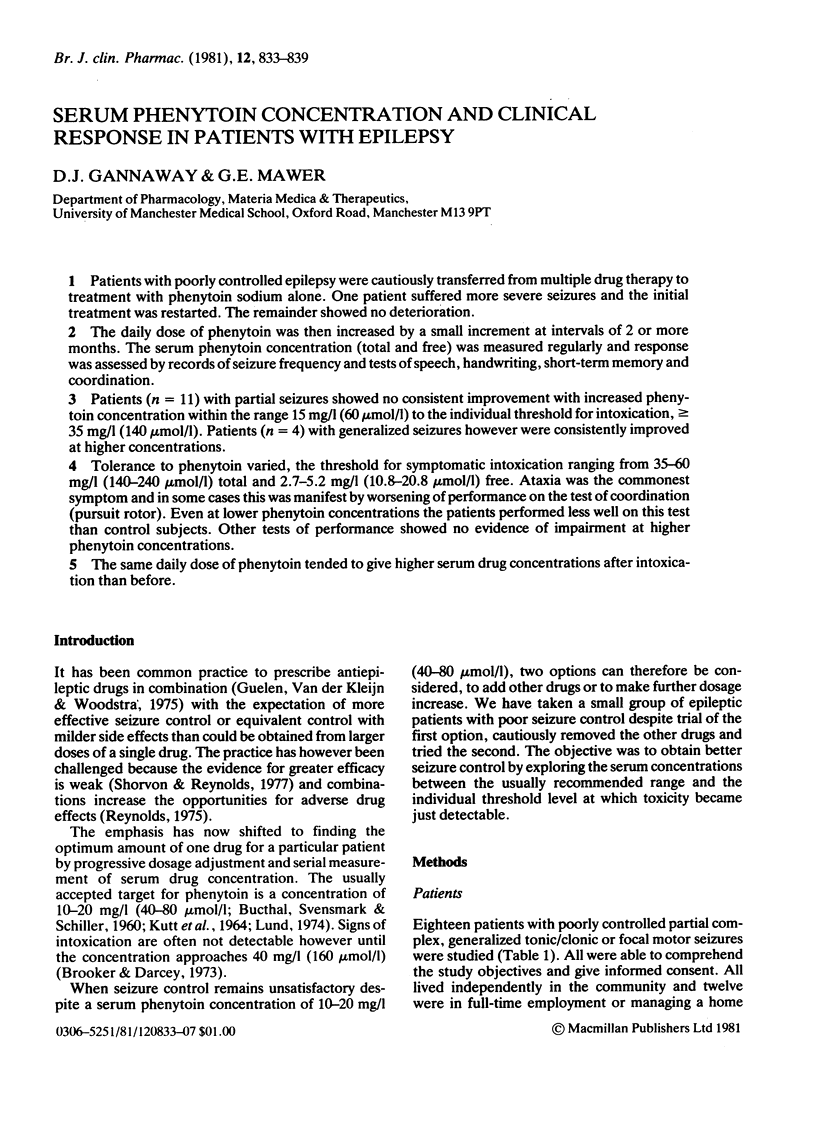
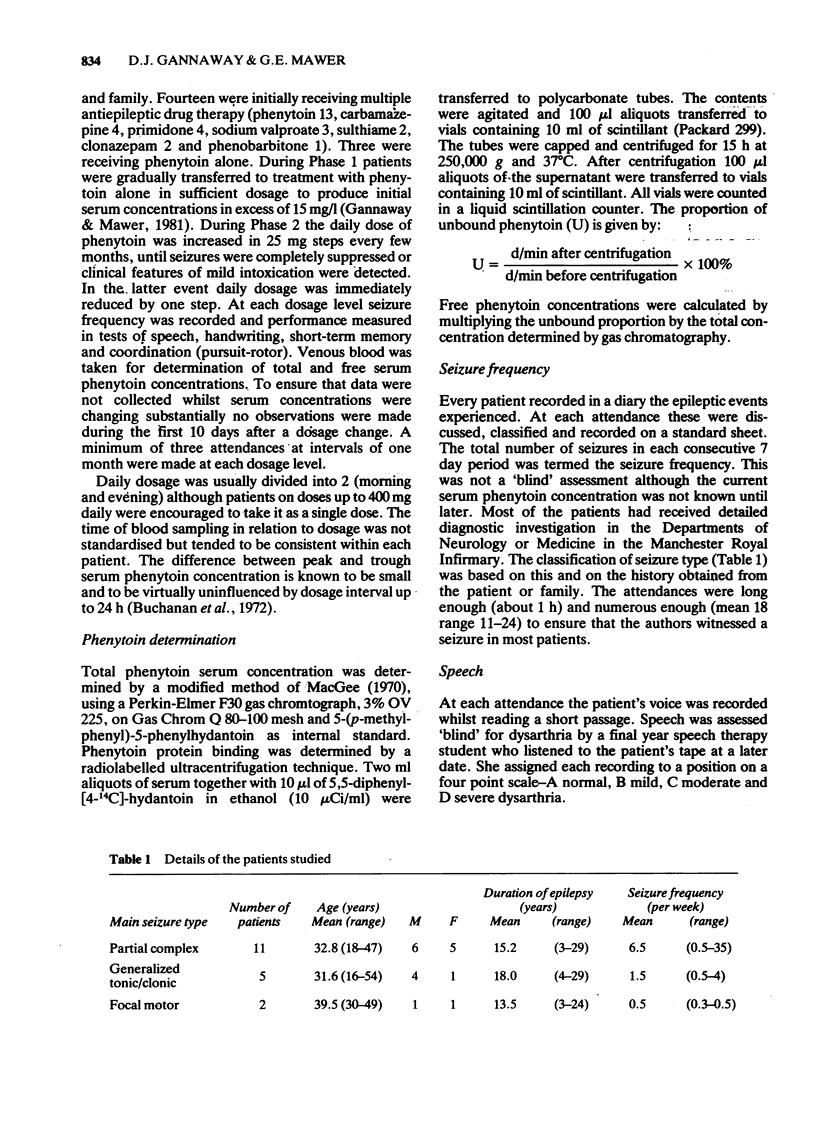
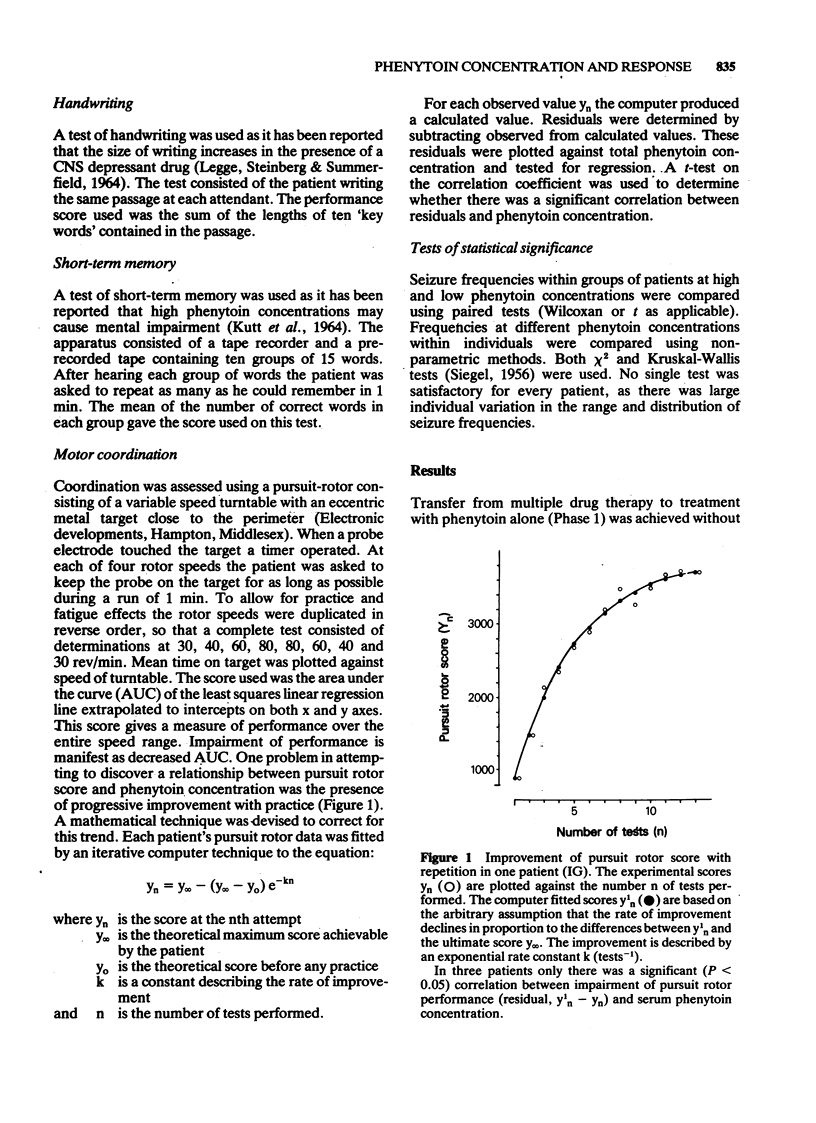


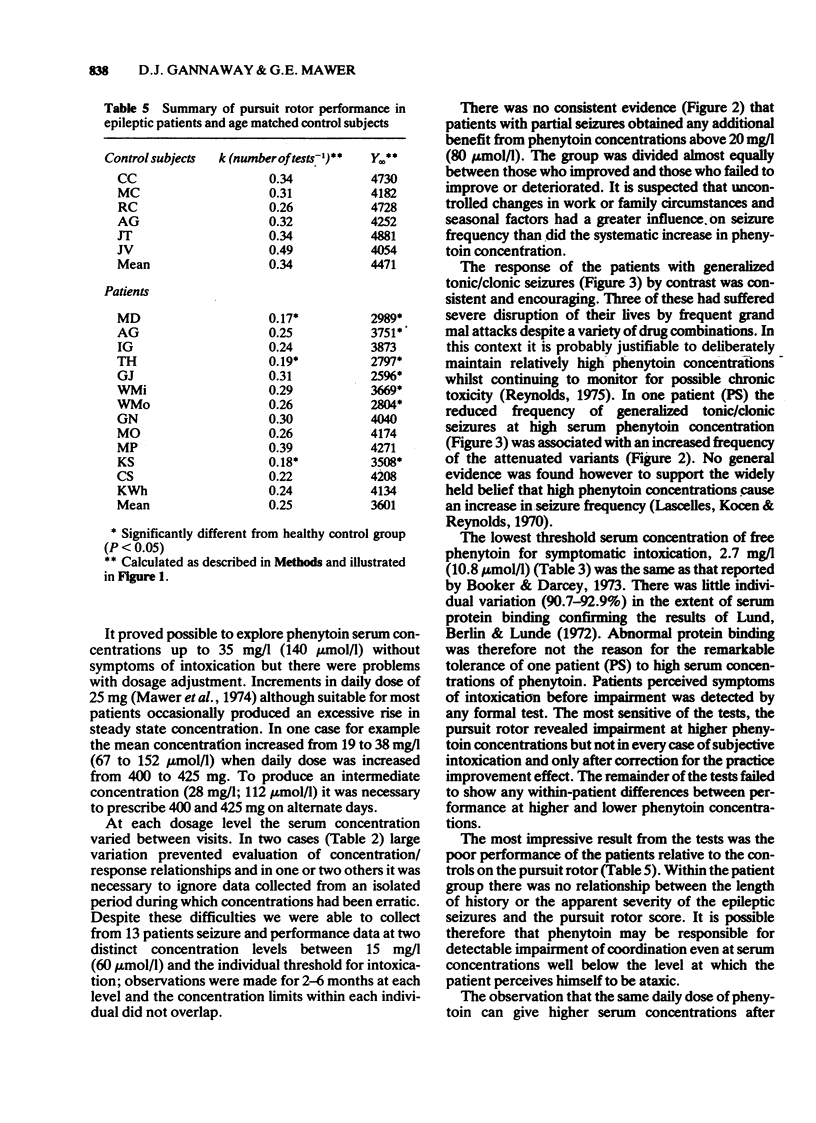
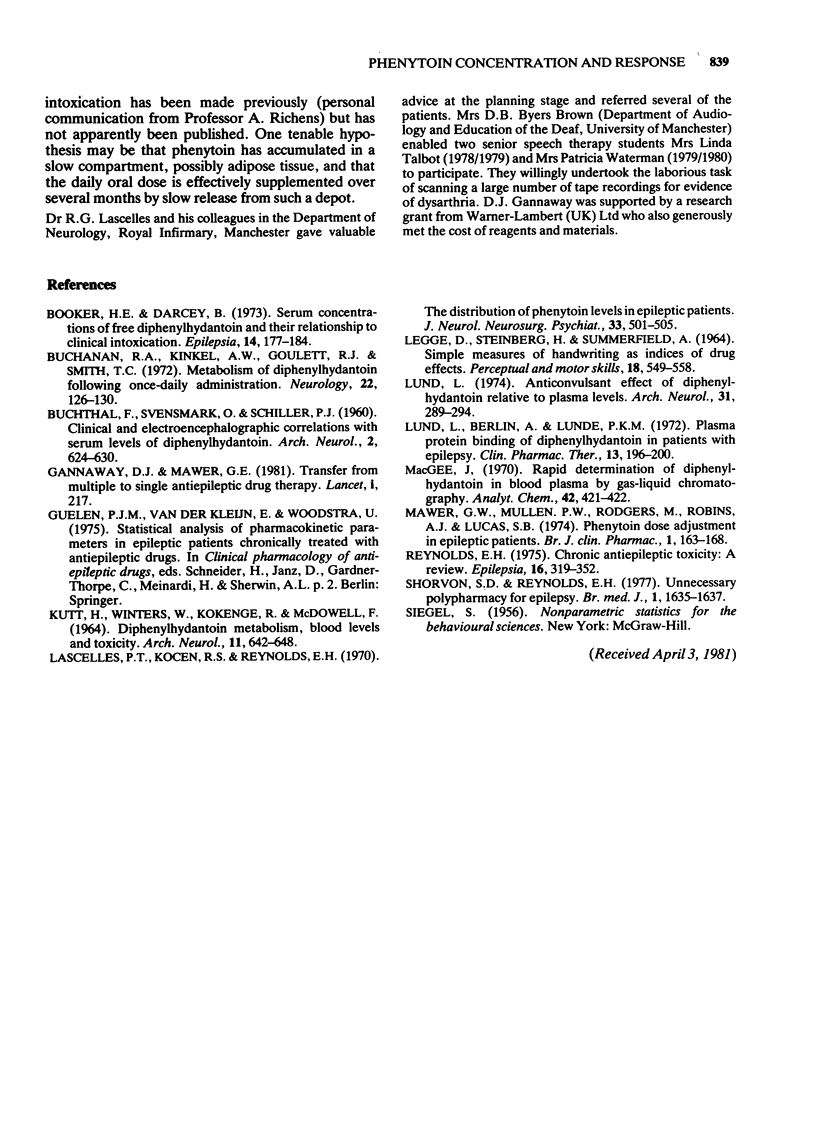
Selected References
These references are in PubMed. This may not be the complete list of references from this article.
- BUCHTHAL F., SVENSMARK O., SCHILLER P. J. Clinical and electroencephalographic correlations with serum levels of diphenylhydanotin. Arch Neurol. 1960 Jun;2:624–630. doi: 10.1001/archneur.1960.03840120030004. [DOI] [PubMed] [Google Scholar]
- Booker H. E., Darcey B. Serum concentrations of free diphenylhydantoin and their relationship to clinical intoxication. Epilepsia. 1973 Jun;14(2):177–184. doi: 10.1111/j.1528-1157.1973.tb03954.x. [DOI] [PubMed] [Google Scholar]
- Buchanan R. A., Kinkel A. W., Goulet J. R., Smith T. C. The metabolism of diphenylhydantoin (Dilantin) following once-daily administration. Neurology. 1972 Feb;22(2):126–130. doi: 10.1212/wnl.22.2.126. [DOI] [PubMed] [Google Scholar]
- Gannaway D. J., Mawer G. E. Transfer from multiple to single antiepileptic drug therapy. Lancet. 1981 Jan 24;1(8213):217–217. doi: 10.1016/s0140-6736(81)90085-4. [DOI] [PubMed] [Google Scholar]
- KUTT H., WINTERS W., KOKENGE R., MCDOWELL F. DIPHENYLHYDANTOIN METABOLISM, BLOOD LEVELS, AND TOXICITY. Arch Neurol. 1964 Dec;11:642–648. doi: 10.1001/archneur.1964.00460240074010. [DOI] [PubMed] [Google Scholar]
- LEGGE D., STEINBERG H., SUMMERFIELD A. SIMPLE MEASURES OF HANDWRITING AS INDICES OF DRUG EFFECTS. Percept Mot Skills. 1964 Apr;18:549–558. doi: 10.2466/pms.1964.18.2.549. [DOI] [PubMed] [Google Scholar]
- Lascelles P. T., Kocen R. S., Reynolds E. H. The distribution of plasma phenytoin levels in epileptic patients. J Neurol Neurosurg Psychiatry. 1970 Aug;33(4):501–505. doi: 10.1136/jnnp.33.4.501. [DOI] [PMC free article] [PubMed] [Google Scholar]
- Lund L. Anticonvulsant effect of diphenylhydantoin relative to plasma levels. A prospective three-year study in ambulant patients with generalized epileptic seizures. Arch Neurol. 1974 Nov;31(5):289–294. doi: 10.1001/archneur.1974.00490410037002. [DOI] [PubMed] [Google Scholar]
- Lund L., Berlin A., Lunde K. M. Plasma protein binding of diphenylhydantoin in patients with epilepsy. Agreement between the unbound fraction in plasma and the concentration in the cerebrospinal fluid. Clin Pharmacol Ther. 1972 Mar-Apr;13(2):196–200. doi: 10.1002/cpt1972132196. [DOI] [PubMed] [Google Scholar]
- MacGee J. Rapid determination of diphenylhydantoin in blood plasma by gas-liquid chromatography. Anal Chem. 1970 Mar;42(3):421–422. doi: 10.1021/ac60285a024. [DOI] [PubMed] [Google Scholar]
- Reynolds E. H. Chronic antiepileptic toxicity: a review. Epilepsia. 1975 Jun;16(2):319–352. doi: 10.1111/j.1528-1157.1975.tb06062.x. [DOI] [PubMed] [Google Scholar]
- Shorvon S. D., Reynolds E. H. Unnecessary polypharmacy for epilepsy. Br Med J. 1977 Jun 25;1(6077):1635–1637. doi: 10.1136/bmj.1.6077.1635. [DOI] [PMC free article] [PubMed] [Google Scholar]


